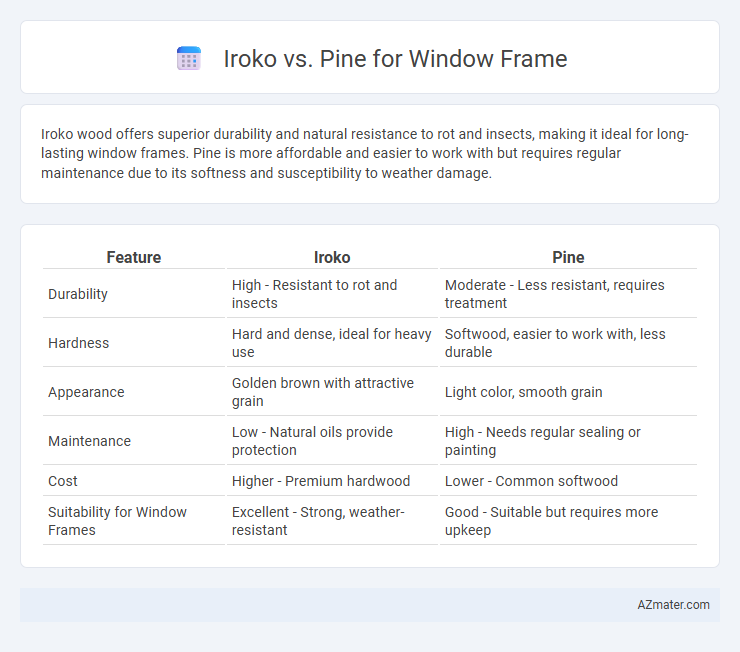Iroko wood offers superior durability and natural resistance to rot and insects, making it ideal for long-lasting window frames. Pine is more affordable and easier to work with but requires regular maintenance due to its softness and susceptibility to weather damage.
Table of Comparison
| Feature | Iroko | Pine |
|---|---|---|
| Durability | High - Resistant to rot and insects | Moderate - Less resistant, requires treatment |
| Hardness | Hard and dense, ideal for heavy use | Softwood, easier to work with, less durable |
| Appearance | Golden brown with attractive grain | Light color, smooth grain |
| Maintenance | Low - Natural oils provide protection | High - Needs regular sealing or painting |
| Cost | Higher - Premium hardwood | Lower - Common softwood |
| Suitability for Window Frames | Excellent - Strong, weather-resistant | Good - Suitable but requires more upkeep |
Introduction to Iroko and Pine Wood
Iroko wood, known as African teak, is prized for its durability, rich golden-brown color, and natural resistance to decay and termites, making it ideal for window frames in humid climates. Pine wood, a softwood, is lighter, more affordable, and easier to work with, but requires treatment to enhance its resistance to moisture and pests. Choosing between Iroko and Pine depends on balancing budget constraints with the need for longevity and strength in window frame applications.
Key Differences Between Iroko and Pine
Iroko and pine wood differ significantly in durability, with iroko being a hardwood known for exceptional resistance to rot and insect damage, making it ideal for long-lasting window frames. Pine, a softwood, is more affordable and easier to work with but requires regular treatment to prevent moisture damage and decay. Iroko's natural oils contribute to low maintenance and weather resistance, whereas pine frames often need protective coatings to extend their lifespan.
Durability and Lifespan Comparison
Iroko wood offers superior durability and resistance to rot, decay, and insect attacks compared to pine, making it an excellent choice for window frames exposed to harsh weather conditions. Pine, being a softwood, tends to have a shorter lifespan and requires regular treatment to prevent warping and damage from moisture. With proper maintenance, iroko window frames can last over 50 years, whereas pine frames typically last around 15 to 20 years before needing replacement.
Resistance to Weather and Pests
Iroko wood offers superior resistance to weather and pests compared to pine, making it a durable choice for window frames exposed to harsh climatic conditions. Its dense grain and natural oils provide excellent protection against rot, decay, and insect attacks, unlike pine which is softer and more prone to damage without proper treatment. This inherent resilience allows Iroko to maintain structural integrity and appearance over time, reducing maintenance and replacement costs.
Aesthetic Appeal and Grain Patterns
Iroko wood offers a rich, golden to dark brown hue with a distinctive coarse grain pattern that enhances window frames with a tropical and elegant aesthetic. Pine features a lighter, creamy color with prominent knots and a straight, uniform grain, giving window frames a rustic and classic charm. The choice between Iroko and Pine significantly impacts the visual warmth and texture of window frames, with Iroko providing a more exotic and durable look compared to Pine's softer, more traditional appearance.
Maintenance Requirements for Each Wood
Iroko wood requires minimal maintenance due to its natural resistance to rot, insect attacks, and weathering, making it ideal for window frames exposed to varying climates. Pine, while more affordable, demands regular sealing or painting to prevent moisture damage, decay, and insect infestation, especially in outdoor applications. Proper maintenance of pine window frames includes routine inspections and timely reapplications of protective coatings to ensure durability and longevity.
Environmental Impact and Sustainability
Iroko wood, known for its durability and natural resistance to decay, offers a more sustainable option due to its slower growth rate and certification under sustainable forestry practices like FSC, reducing deforestation impact. Pine, while faster-growing and more readily renewable, often requires chemical treatments to enhance durability for window frames, which can introduce environmental toxins. Choosing Iroko supports longer-lasting window frames with less need for replacement, minimizing waste, whereas pine's rapid renewability balances environmental impact with maintenance considerations.
Cost Comparison: Iroko vs Pine
Iroko window frames typically cost between $30 to $45 per linear foot, reflecting their durability and resistance to decay, while pine frames range from $10 to $20 per linear foot, offering a more budget-friendly option. The higher upfront cost of Iroko is often offset by its longevity and lower maintenance requirements compared to pine, which may require frequent painting and treatment to prevent rot. Choosing between Iroko and pine depends on balancing initial investment against long-term value in window frame applications.
Installation and Workability Factors
Iroko wood offers superior workability for window frame installation due to its dense, durable nature, allowing for precise cuts and strong joinery, while also providing resistance to rot and insect damage. Pine, being softer and lighter, is easier to machine and shape but may require additional treatment to enhance durability and weather resistance during installation. The installation process with Iroko often demands specialized tools and expertise, whereas Pine allows for quicker, more straightforward handling and fastening.
Best Choice for Window Frames: Iroko or Pine?
Iroko wood offers superior durability and natural resistance to rot and insect damage compared to pine, making it an ideal choice for window frames in humid or exterior environments. Pine is more affordable and easier to work with but requires regular treatment and maintenance to prevent moisture damage. For long-term performance and reduced upkeep, Iroko is the best choice for window frames.

Infographic: Iroko vs Pine for Window Frame
 azmater.com
azmater.com